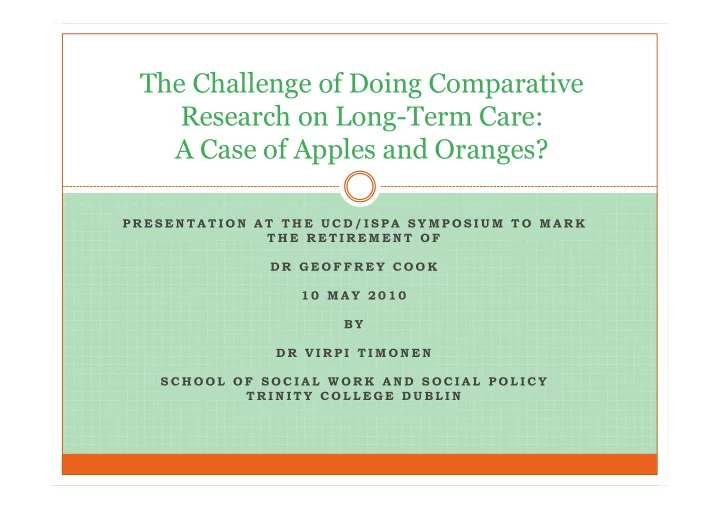

The Challenge of Doing Comparative Research on Long�Term Care: A Case of Apples and Oranges? � � � � � � � � � � � � �� � � � � � � � � � � � � � � � � � � � � � � � � �� � � � � � � � � � � � � � � � � � � � � � �� � � � � � � � � � � � � � �� � � � � � � � � � � � � � � � � � � � � � � � � � � � � � � � � � � � � � � �� � � � � � � � � � � � � � � � � � � � � � � � � � � � � � � � � � � � � � � �� � � � � � � � � � � � � �
Gerson Lehrman Group
Comparing welfare states and social policies � Early focus on transfers (expenditure, other measures of ‘welfare effort’), structures & outcomes (poverty) � Increasing prominence and importance of care & Increasing prominence and importance of care & services, especially long�term care (LTC) of older people � Challenges involved in comparing (formal) LTC
Alber (1995) Framework for the Comparative Study of Social Services ������������������������������������������������������������������������� ������������������������������������������������������������������������� ������������������������������������������������������������������������������ �������������������������������������������������������������������� ��������������������������������������������������� � Define dimensions of variation and map variations within these dimensions: dimensions: ����������� , ������ (facilities, staff), ������� � Variables that may help to explain these variations: ���������������������� : regulation, financing, delivery, consumer power → Importance of ����������������� and ����������������������� (class / power relations)
Home care: Motherhood and Apple pie WRAMSOC � Timonen (2005): (only) two common developments across seven countries: (1) prioritising home care, (2) emergence of private providers Care of older people in their own home is universally Care of older people in their own home is universally acknowledged as ‘good’; policy AIM shared by all countries; increasing recognition of formal (paid) care in this sphere The challenges of comparing policies trained at this ‘universal good’ are arguably now greater than ever:
Data quality and availability � Often scattered and locally based nature of social care policies, great diversity within and across countries. � Increasingly difficult to distinguish home care from residential care within countries. � Data on institutional care more readily available than � Data on institutional care more readily available than data on home care. � Compared with the childcare sector, still little systematic effort at data collection for the various kinds of provision and their coverage. (OECD 2007; Saraceno 2010)
Care in the home and policies around it are complex � ‘Care’ is diverse: nursing, personal (ADL), domestic (IADL): some statistics look at both, some only one of these � Challenge of defining ‘home’ (supported housing?) � Purchaser and provider often different entities � ‘Purchaser’ can be care recipient (his/her family), the State � ‘Purchaser’ can be care recipient (his/her family), the State � Increasingly widespread practice of ‘delegating’ the purchasing function to care recipient who has ‘free choice’ to select a provider � ‘Provider’ can be informal (family) or formal � Within formal, can be public, private or non�profit organisation INHERENTLY MORE COMPLEX THAN INCOME TRANSFERS & GETTING MORE COMPLEX AND HARDER TO MEASURE
Extracts from OECD (2005) Glossary LONG�TERM CARE (LTC): A range of services needed for persons who are dependent on help with basic activities of daily living. C.f. Huber et al. (2009): ADL AND IADL HOME CARE: HOME CARE: LTC services that can be provided to patients at home. This includes day care and respite services �������� ���� [sic]. Includes LTC received in home�like settings such as assisted living facilities ��������� �������������������������������������������������� �������������� .
Centrality of Concepts & Comparability � Stipulation of concepts should precede collection of data → guide search for and selection of both quant and qual empirical material � The better the concepts, the better the variables The better the concepts, the better the variables � Amassing material in the absence of sound concepts leads to the data ‘sinking under its own weight’ � Precondition for comparison is the identification of comparable, ������������������������������������ units of analysis. (Rose, 1991)
That old apples and oranges dilemma...
Levels of comparison (and required comparability) Policy Aims Policy Policy Instruments Delivery Outcomes
������������������������������� (Timonen, Convery and Cahill 2006)
Commonalities across most different cases � Diverse systems – that represent ‘most different cases’ � can produce similar policy ‘aims’ and ‘aspirations’ � What do these cases have in common that could explain the similarity in policy aims?
������������������� ����������� ������!���������!������"���������### ( Adapting typology from Saraceno 2010) $�"��� ��� �������������� '�����"����� ������������� ����� ����� )����� ����������"�(�� ���� %$���������� %��#��������������"& ���������&� UK √ √ Familialism by default Germany √√ √ √ Supported familialism Denmark √√√ √√ √√√ De� familialism Ireland √ √√ √ Familialism by default
‘Models’ and Most similar cases In ‘most similar’ design, it is important that the cases share membership in a meaningful, empirically defined category � Categories / types / models that can be used to guide case selection: case selection: But how far do the models take us? Within each ‘most similar’ category we can find a great deal of variance
*����������������������������������'��������'���� �����������!��� '������ ����� '��������� '��� ����������� �������� UK Both √ √√√ Germany Cash √√ √√ Denmark In�kind N / A √ Ireland Both √ √√
‘Delivery’: ‘The very mixed economy of care’ in Ireland ������� ������� ����� ���������� �������������� ��������� ����� ������ ������ ��������
$����$���������+�����,� � -���-�����.����������/������ $�����������'����� (Timonen and Doyle 2007) ������ ������ ������� ���������� �������� ���!���� %���!���� ���!���������� ����� ���� &��� $�%���!����&��� ����������! �������!�����#� ����������� &����!������ �� �"���# '��!(���������! ��)(�!# �������!�����# "�����! ��)����! '��!(���������!
�0����������1�������(��2������������������������������� ������������� (Huber et al. 2009)
Recommend
More recommend